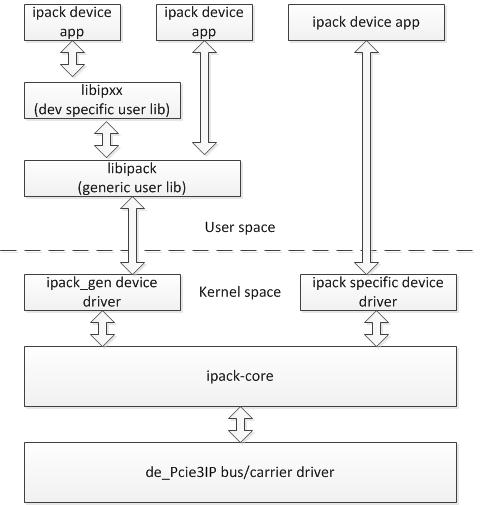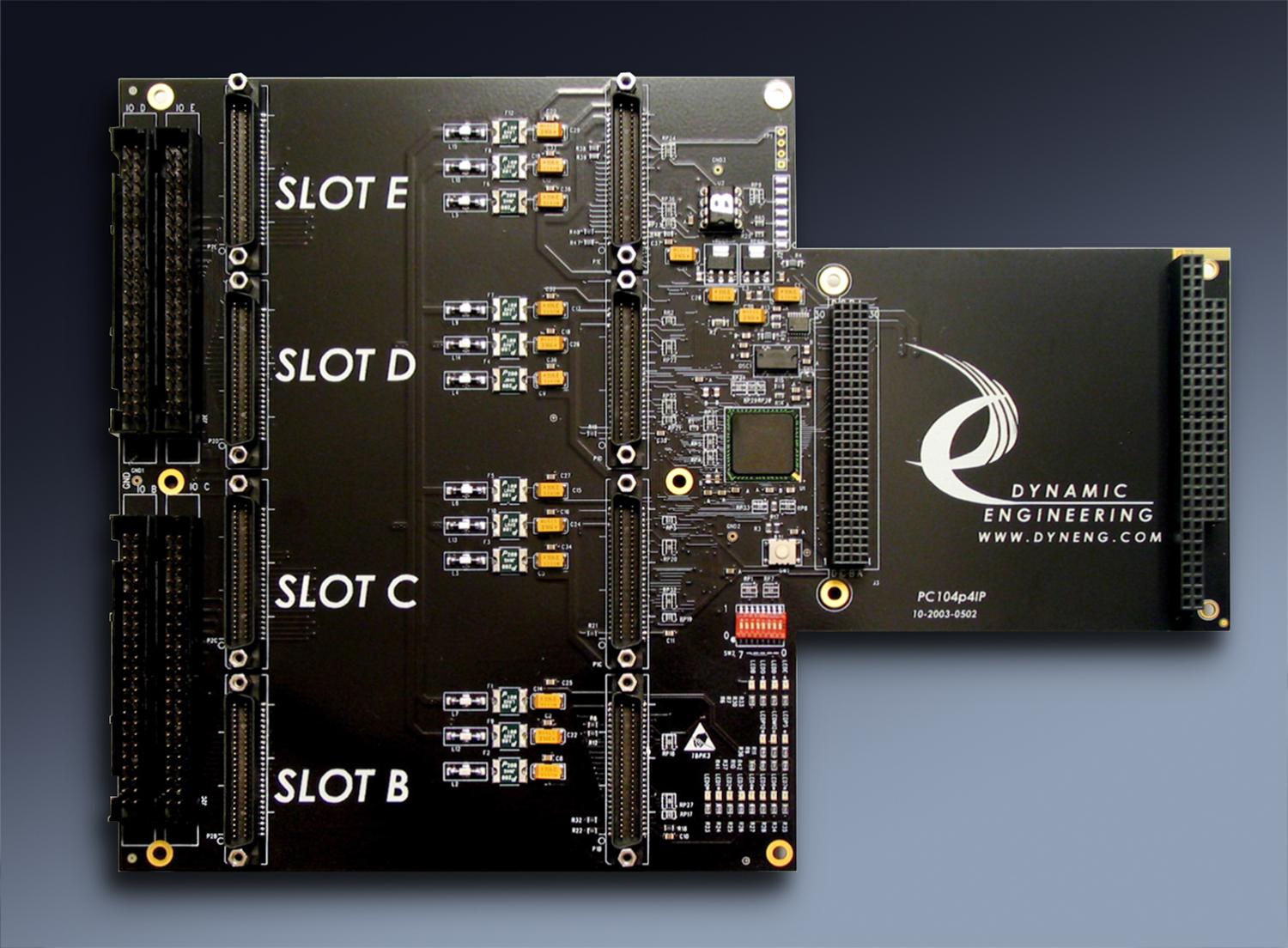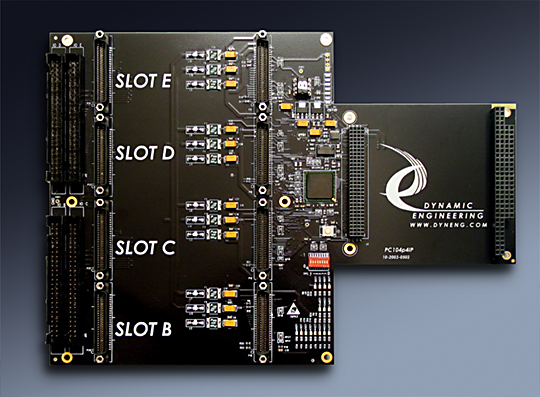PC104p4IP
PCI-104 bridge to 4 IndustryPack Modules.
Order This Item
PC104p4IP Description
- Windows® , Linux driver included with purchase
- 4 IndustryPack Module positions w/ 8⇆32 MHz. operation
- Independent IP control buses with overlapped instruction execution
- Fused, FIltered 5V, +12V, -12V supplied to each IP
- Multi-word accesses supported including 32, 16, 8 bit to IPs
- Full memory space supplied to each position
- 32/33 PCI operation, 8, 16, 32 bit IP operatoin
- Standard footprint for PCI/ISA connectors
- Ribbon Cable Header
- 1 year warranty standard. Extended warranty available.
- ROHS and Standard processing available
IndustryPack® Modules are an important part of solutions for Embedded situations. Rugged, small, light .. just right for many applications. IndustryPack® Modules require a "carrier" in most cases to adapt them to the system. Dynamic Engineering has carrier solutions for a variety of formats. PC104p4IP is designed to support PCI-104 solutions. Alternate types available available for VPX, cPCI, and PCI, PCIe and planned for cPCIexpress, PC104express.
PC104p4IP is part of the IP Compatible family of modular I/O components. PC104p4IP provides four IndustryPack® module sites in one PCI-104 stack position. PC104p4IP acts as an adapter, converter, carrier, and bridge between the PCI bus and your IndustryPack® hardware.
PC104p4IP is supported with Windows® compliant drivers as well as Linux support. The drivers come with a generic IP driver to allow use with "unknown" IPs ↔ IPs that do not have a driver designed yet. For example, third party IP modules.
IndustryPacks are 16 bit devices, and the PCI bus supports larger payloads. PC104p4IP converts to word accesses. Most modern CPU´s can generate 8, 16, 32 and 64 bit instructions. The IP accesses can be auto-incremented or static address accesses. With the static access option the intended word can be accessed multiple times. With auto-incremented addresses multiple addresses are accessed.
A typical system might have a PCI-104 CPU with Power supply in the PC104p stack and special purpose IO in the IP positions. PC104pPWR-28, PC104pCOOL [Fans], PC104pRPP [Reverse Power Protection and fan] are available options to support the PC104p side of the design. IP-1553, IP-429, IP-Parallel-IO, IP-BiSerial-VI and many more modules are available. A small, rugged system can be achieved in this manner. For more information on the above cards please use the menu system to navigate.
Multi-board operation is supported. With multiple PC104p4IP´s in your system and unique cabling, sensors etc. for each slot on each PC104p4IP it is important to "know" which PC104p4IP is which, and to properly control the IP modules mounted to them. A surface mount "dip switch" is provided to create an identifier for the software. A specific PC104p4IP can be matched with the PCI address allocated for deterministic control. The switch can also be used for other purposes; configuration control or debugging for example. The switch values are available to be read via the PCI bus.
The Dynamic Engineering implementation does not require any special features on your IP module. Larger transfer sizes are especially useful for repetitive data transfers - loading or reading from RAM or FIFOs faster will reduce the overhead on your CPU leading to more available time to process the data leading to lower cost or more capable systems.
Each position has a separate clock controller for 8 and 32 MHz operation. The frequency to be changed on the fly. The state-machine within the bridge design automatically locks to the IP Slot frequency as programmed.
Slots B/C and D/E are configured to accept two single IPs, or a double wide Industrypack compatible design. The data bus is designed to allow for 32 bit IP Bus operation. The data bus width is controlled by the address range the slot is controlled with. Automatic switching makes it possible to switch data bus size without changing the control registers for seamless operation.
Each IP position has "self healing" fused, filtered power. Each IP Module has separate bulk and bypass capacitance.
Industry standard 50 pin [ribbon cable] headers are used with the IO connectors. Vertical connectors are provided in all positions. Ribbon cable or discrete wire cables can be interfaced directly with the PC104p4IP. The traces between the IP IO connector and the PC104pIP IO connector have matched length [within .002"] for each slot independently. HDRterm50 can be used to create a terminal block interface.
The IP´s can be reset from the control register within the FPGA via the software interface. In addition at power-up the IP´s are provided the 200 mS reset as required by specification.
LED´s are provided to each of the IP slots for activity indicators. When each slot is accessed the LED is flashed. The FPGA provides a "one shot" circuit to stretch the "on" time to make it visible. Power indicator LED´s are provided using voltage monitors. An additional eight user LED´s are available for debugging or other purposes.
IP accesses are protected by a watch-dog timer. The timer is started at the beginning of each IP access. If the timer expires before the IP being accessed responds, a bus error internal to the PC104p4IP is created. PC104p4IP responds normally to the host, not creating an errror on the PCIe bus, and provides status and an optional interrupt to alert the host to the problem with the IP. The Bus Error timer is useful in situations where the software may want to cause a bus error to find out what is installed or where a hung system would have consequences.
Connector positioning is compatible with IP-Debug-Bus will allow the user to isolate and debug the control interface of an IP. IP-Debug-IO can be used in conjunction with PC104p4IP and IP-Debug-Bus to provide test-points on the IO signals and loop-back capability for the IP.
PC104p4IP is part of the IP Compatible family of modular I/O components. PC104p4IP provides four IndustryPack® module sites in one PCI-104 stack position. PC104p4IP acts as an adapter, converter, carrier, and bridge between the PCI bus and your IndustryPack® hardware.
PC104p4IP is supported with Windows® compliant drivers as well as Linux support. The drivers come with a generic IP driver to allow use with "unknown" IPs ↔ IPs that do not have a driver designed yet. For example, third party IP modules.
IndustryPacks are 16 bit devices, and the PCI bus supports larger payloads. PC104p4IP converts to word accesses. Most modern CPU´s can generate 8, 16, 32 and 64 bit instructions. The IP accesses can be auto-incremented or static address accesses. With the static access option the intended word can be accessed multiple times. With auto-incremented addresses multiple addresses are accessed.
A typical system might have a PCI-104 CPU with Power supply in the PC104p stack and special purpose IO in the IP positions. PC104pPWR-28, PC104pCOOL [Fans], PC104pRPP [Reverse Power Protection and fan] are available options to support the PC104p side of the design. IP-1553, IP-429, IP-Parallel-IO, IP-BiSerial-VI and many more modules are available. A small, rugged system can be achieved in this manner. For more information on the above cards please use the menu system to navigate.
Multi-board operation is supported. With multiple PC104p4IP´s in your system and unique cabling, sensors etc. for each slot on each PC104p4IP it is important to "know" which PC104p4IP is which, and to properly control the IP modules mounted to them. A surface mount "dip switch" is provided to create an identifier for the software. A specific PC104p4IP can be matched with the PCI address allocated for deterministic control. The switch can also be used for other purposes; configuration control or debugging for example. The switch values are available to be read via the PCI bus.
The Dynamic Engineering implementation does not require any special features on your IP module. Larger transfer sizes are especially useful for repetitive data transfers - loading or reading from RAM or FIFOs faster will reduce the overhead on your CPU leading to more available time to process the data leading to lower cost or more capable systems.
Each position has a separate clock controller for 8 and 32 MHz operation. The frequency to be changed on the fly. The state-machine within the bridge design automatically locks to the IP Slot frequency as programmed.
Slots B/C and D/E are configured to accept two single IPs, or a double wide Industrypack compatible design. The data bus is designed to allow for 32 bit IP Bus operation. The data bus width is controlled by the address range the slot is controlled with. Automatic switching makes it possible to switch data bus size without changing the control registers for seamless operation.
Each IP position has "self healing" fused, filtered power. Each IP Module has separate bulk and bypass capacitance.
Industry standard 50 pin [ribbon cable] headers are used with the IO connectors. Vertical connectors are provided in all positions. Ribbon cable or discrete wire cables can be interfaced directly with the PC104p4IP. The traces between the IP IO connector and the PC104pIP IO connector have matched length [within .002"] for each slot independently. HDRterm50 can be used to create a terminal block interface.
The IP´s can be reset from the control register within the FPGA via the software interface. In addition at power-up the IP´s are provided the 200 mS reset as required by specification.
LED´s are provided to each of the IP slots for activity indicators. When each slot is accessed the LED is flashed. The FPGA provides a "one shot" circuit to stretch the "on" time to make it visible. Power indicator LED´s are provided using voltage monitors. An additional eight user LED´s are available for debugging or other purposes.
IP accesses are protected by a watch-dog timer. The timer is started at the beginning of each IP access. If the timer expires before the IP being accessed responds, a bus error internal to the PC104p4IP is created. PC104p4IP responds normally to the host, not creating an errror on the PCIe bus, and provides status and an optional interrupt to alert the host to the problem with the IP. The Bus Error timer is useful in situations where the software may want to cause a bus error to find out what is installed or where a hung system would have consequences.
Connector positioning is compatible with IP-Debug-Bus will allow the user to isolate and debug the control interface of an IP. IP-Debug-IO can be used in conjunction with PC104p4IP and IP-Debug-Bus to provide test-points on the IO signals and loop-back capability for the IP.
PC104p4IP Features
Size
PCI-104 / PC104p card with extension for IP modules. See downloadable PDF for mechanical data.
IP compatible slots
4 independent slots. Slots B/C and/or D/E can be used together for a double wide or 32 bit IP
Clocks
8 and 32 MHz operation. Clock selection can be changed on-the-fly with glitch free operation.
Access Width
Each position can be accessed as byte, word, or multiple word payload [x32, x64 etc]. Multiple word accesses can be static or auto-incrementing to the IP slot.
Bus Error
The Watch-Dog timer protects against PCIe bus hangs by responding when the IP is not installed or has a failure.
Cable interface
Industry standard 50 pin box headers.
Software Interface
Control registers are read-writeable
IO, ID, MEM, INT spaces supported.
Windows® and Linux Drivers available
IO, ID, MEM, INT spaces supported.
Windows® and Linux Drivers available
Interrupts
Each IP has 2 potential interrupts. Control registers are provided to enable amd tailor the pace at which interrupts are sent to the host and Status registers are provided to determine the source of the interrupt.
Power Requirement
+5V internally, +5V, +12V, -12V current determined by IPs installed Full IP spec power available to each position
DIP switch
An 8 position switch is available to allow for configuration control, or to facilitate debugging, and to provide a positive ID of each PC104p4IP in your system
LEDs
+5V, +12V, -12V and activity LEDs. 8 user LEDs also available
PC104p4IP Benefits
Speed
With the direct PCI to IP Bridge design featured in the PC104p4IP the access to your hardware happens faster than in competing designs. Throughput is increased by an additional 50% when the 32 bit access mode is used. Fantastic for loading memory etc.
Price
System level cost is best when reasonably priced reliable hardware is used and NRE minimized. With PC104p4IP, driver support for the carrier and IP level, reference software, history of reliable operation, and fantastic client support your cost per unit and overall costs are attractive. Orders can be placed via the on-line ordering system or via phone / email PO order systems.
Ease of Use
PC104p4IP is easy to use. A point and shoot user interface to the IP sites. Please download the manuals and see for yourself. Reference software is provided in source form to get you started. The generic IP interface allows the driver to be used with IP´s without a driver specific to that design.
Availability
We work to keep PC104p4IP in stock. With our on-site manufacturing capability larger orders and out-of-stock situations are resolved quickly.
IP Specification Compatibility
PC104p4IP is IP compliant per the VITA 4 - 1995 specification. All Dynamic Engineering IP Modules are compatible with PC104p4IP. All other IP Modules which are compliant with the VITA specification can be expected to work. ID, IO, INT, and Memory spaces are supported.
PCI Compatibility
PC104p4IP is universal voltage, PCI compliant device. PC104p4IP can be expected to work in any PCI-104 stack.
Part Number: PC104p4IP
Ordering Options
- PC104p4IP Standard board - 4 IP positions, 8 and 32 MHz IP operation, automatic 32 bit conversion Add -options as desired
- -ROHS Use ROHS processing. Standard processing is ""leaded"
- -CC Option to add Conformal Coating
PC104p4IP Drivers
Software Support for PC104p4IP includes: Windows®, Linux compliant drivers
Please see the Driver manuals for the specifics of each type.
The drivers are designed to be overlayed with individual IP Module(s) driver(s). IP drivers are auto installed for each instance detected. Please see the Driver manual for the specifics of writing your board interface. Please contact Dynamic Engineering if you would like us to produce one for your IP or a third party design. Our Windows and Linux drivers come with IP-Generic which is automatically installed when a specific driver is not found for a particular IP Module. IP-Generic can be used to control your IP including handling interrupts, and accesses to all 4 space types.
Linux
The PC104pIP Linux driver is a bus driver capable of supporting multiple (up to 64) Industry Pack buses/carrier cards. This driver interfaces with the ipack-core Open Source code to support Industry Pack devices. This Open Source code has been slightly modified, and is included with the tar-ball for this driver.
A generic IPACK driver (ipack_gen) and user library (libipack) has been developed by Dynamic Engineering. This driver and library may be sufficient for developing user space drivers for a device depending upon the complexity of that device. Other device specific user libraries and kernel drivers are available for Dynamic Engineering Industry Pack modules. The diagram below illustrates possible layering of Industry Pack components:

Integration support is available. Please contact Dynamic Engineering for this option or download the Technical Support Description from the Company button.
Please see the Driver manuals for the specifics of each type.
The drivers are designed to be overlayed with individual IP Module(s) driver(s). IP drivers are auto installed for each instance detected. Please see the Driver manual for the specifics of writing your board interface. Please contact Dynamic Engineering if you would like us to produce one for your IP or a third party design. Our Windows and Linux drivers come with IP-Generic which is automatically installed when a specific driver is not found for a particular IP Module. IP-Generic can be used to control your IP including handling interrupts, and accesses to all 4 space types.
Linux
The PC104pIP Linux driver is a bus driver capable of supporting multiple (up to 64) Industry Pack buses/carrier cards. This driver interfaces with the ipack-core Open Source code to support Industry Pack devices. This Open Source code has been slightly modified, and is included with the tar-ball for this driver.
A generic IPACK driver (ipack_gen) and user library (libipack) has been developed by Dynamic Engineering. This driver and library may be sufficient for developing user space drivers for a device depending upon the complexity of that device. Other device specific user libraries and kernel drivers are available for Dynamic Engineering Industry Pack modules. The diagram below illustrates possible layering of Industry Pack components:

Integration support is available. Please contact Dynamic Engineering for this option or download the Technical Support Description from the Company button.
PC104p4IP Manuals
Click on the link to Download selected manuals in PDF format.
Download the PC104p4IP Manual in PDF format.
Download the PC104p4IP Mechanical in PDF format.
Download the IP Carrier Windows®10 manual. For PCIe and PCI based carriers
Download the Win10 Generic IP Driver Manual in PDF format.
Download the IP Carrier Windows®7 manual. For PCIe and PCI based carriers
Download the IP Carrier and Module Quick Start guide for Windows®7
Download the Win7 Generic IP Driver Manual in PDF format.
Download the IP Carrier Linux Manual
Download the Linux IP Module Manual
Download the PC104p4IP Statement of Volatility
Download the PC104p4IP Manual in PDF format.
Download the PC104p4IP Mechanical in PDF format.
Download the IP Carrier Windows®10 manual. For PCIe and PCI based carriers
Download the Win10 Generic IP Driver Manual in PDF format.
Download the IP Carrier Windows®7 manual. For PCIe and PCI based carriers
Download the IP Carrier and Module Quick Start guide for Windows®7
Download the Win7 Generic IP Driver Manual in PDF format.
Download the IP Carrier Linux Manual
Download the Linux IP Module Manual
Download the PC104p4IP Statement of Volatility


